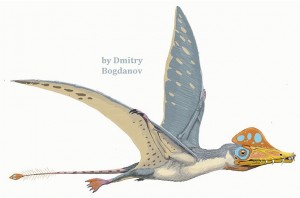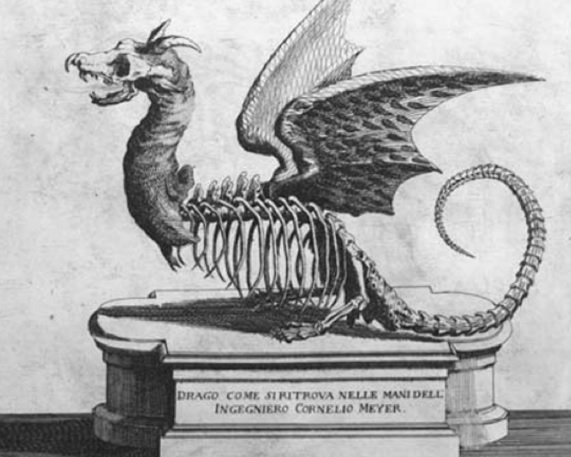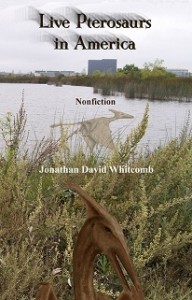Where should we start examining this apparent dragon-hoax/pterosaur-mistake? First, we need to remember that a hoax does not have to be founded on a previous hoax, and that a person may be fooled by a hoax but still promote truth while inadvertently mixing in a mistake. With that said, birds of a feather rarely flock with dragons, so we can understand why a person might disbelieve in any modern pterosaur after learning that some promoters of the idea have been seriously mistaken about one of their evidences. It now appears to me that at least one of my associates has been seriously mistaken about an image in a late-seventeenth century book.
It seems the best thing we can say about the “dragon” image below is that its origin is questionable. I care little about that, however, for even a child can understand that shooting a crow out of the sky cannot cause the extinction of the Snow Goose, notwithstanding how threatening it might appear to all birds.
.
Nuovi ritrovamenti divisi in due parti dell’ingegnere civile olandese Cornelius Meyer
A dragon (above) was reported to have lived in Italy in the 1600’s
.
I never felt comfortable with the above image. To the best of my memory, I never included it in any of my blog posts as evidence for a pterosaur living in human times. But my living-pterosaur associate David Woetzel included it with seventeen lines of text in its support in his scientific paper “The Fiery Flying Serpent” (Creation Research Society Quarterly, Volume 42, March 2006). A recent scientific paper, however, seems to have destroyed the credibility of the image and at least part of the story behind it (“Late-surviving pterosaur?” by Phil Senter and Pondanesa D. Wilkins. 2013. Palaeontological Association. Article number: 16.1.6A).
Nevertheless, the recent paper takes a narrow view, ignoring potential positive aspects of living-pterosaur investigations from the 1990’s to the present. Some of my associates and I, including David Woetzel and Garth Guessman, have explored on Umboi Island, Papua New Guinea, searching for the nocturnal flying creature that the natives call “ropen.” The eyewitness testimonies we recorded, when combined with many other sighting reports from various areas of the world, make the case for modern living pterosaurs. And with the concept of pterosaurs living into the twenty-first century, obviously they would have lived in the 1600’s.
Woetzel wrote, “It seems to be a credible pterosaur specimen” and “some have suggested that it could be a fossil or faked composite, but it is much too accurate to be considered a fabrication.” In my opinion, those particular words in his scientific paper have now been shown to be incorrect, notwithstanding the many points and paragraphs, on other historical evidences, that may be much more accurate; the story of this “dragon” image, however, made up only a tiny fraction of Woetzel’s paper. Senter and Wilkins, in their early-2013 paper, actually discredited only a tiny portion of Woetzel’s paper.
“The Rhamphorhynchoid Pterosaur Scaphognathus crassirostris: A “Living Fossil” Until the 17th Century” (Adapted from a paper presented at the 1998 International Conference on Creation, Geneva, PA)
This paper by John Goertzen appears to be the source of Woetzel’s information on the seventeenth-century “dragon” of Italy. In this 1998 scientific paper, Goertzen referred to this image, noting similarities with an Egyptian sculpture. The 2013 paper by Senter and Wilkins now makes his writings on this dragon image highly questionable, to say the least.
But “Late-surviving pterosaur?” actually says nothing substantial against the countless eyewitness testimonies from sightings of living pterosaurs within the past few decades. It is extremely narrow, apparently written with the assumption that all other ideas about extant pterosaurs are equally flawed.
.

Scaphognathus crassirostris (a “basal” pterosaur)
Many pterosaurs of the suborder Rhamphorhynchoidea (long-tailed) have lived at some time in the past. Goertzen seems to have assumed that Scaphognathus crassirostris (Sc) may have been a species that survived until at least a few centuries ago; perhaps he is right. But if the above image accurately depicts the head crest, then another species may better explain the living-pterosaur evidences from human history. Many of the sighting reports that I have received over the past nine years point to a much more pointed head crest, much like a horn coming out of the back of the head.
The big point, however, is this: overwhelming eyewitness evidence makes the case for modern living pterosaurs, regardless of the questionable aspects of old images of dragons with wings.
###
.
What happens when a child reports a sighting of a live pterosaur or “pterodactyl?” Will an adult care what the child says or believe the account? Children often spend much time outdoors, so they observe what flies overhead. But what if a child reports the same large featherless flying creature that some adults report? If many persons reject the reports of adult eyewitnesses, those skeptics will probably reject the report of a child.
.
Third edition of Live Pterosaurs in America – nonfiction
Excerpt from the above cryptozoology book:
She was twelve years old, at most (around 1995), when she walked out into her backyard one morning to check on the dog . . . [She] found the poor animal cowering around the side of the house, apparently trying to hide behind a banana tree. The girl had no idea what was wrong . . . Fearing it was sick, [The child] was about to run back into the house to tell her mother. . . . She turned her head and saw what it was that had terrified the dog.
. . . in the neighbor’s backyard, was what she first thought was a tall man . . . He was “draped in a long black coat or cape,” facing away from her. “Dracula” came to mind as [the girl] tried to understand what she was looking at. The “man” turned, and revealed a face that terrified the child: It was non-human. . . . the creature . . . unwrapped its bat-like wings, dark leathery wings. The girl had never seen anything remotely like them.
. . . it was nothing like [any bird or bat]: too big, and without feathers. The girl was frozen in fear . . . [It] began to walk towards her. . . .
.
.




